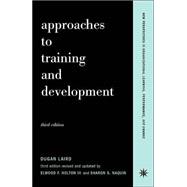
What is included with this book?
| List of Illustrations | xi | ||||
| 1 Why This Book? | 1 | (4) | |||
|
1 | (1) | |||
|
2 | (1) | |||
|
3 | (1) | |||
|
3 | (2) | |||
| 2 The Need for Training and Development Departments | 5 | (16) | |||
|
5 | (1) | |||
|
6 | (3) | |||
|
9 | (1) | |||
|
10 | (3) | |||
|
13 | (1) | |||
|
14 | (2) | |||
|
16 | (5) | |||
| 3 Function and Role of TEtD Managers | 21 | (16) | |||
|
21 | (1) | |||
|
22 | (4) | |||
|
26 | (4) | |||
|
30 | (3) | |||
|
33 | (1) | |||
|
34 | (3) | |||
| 4 The TEtD Department and the Organizational Structure | 37 | (12) | |||
|
37 | (1) | |||
|
37 | (6) | |||
|
43 | (1) | |||
|
44 | (2) | |||
|
46 | (1) | |||
|
47 | (1) | |||
|
48 | (1) | |||
| 5 Identifying Training Needs | 49 | (28) | |||
|
49 | (1) | |||
|
50 | (1) | |||
|
51 | (11) | |||
|
62 | (1) | |||
|
63 | (2) | |||
|
65 | (2) | |||
|
67 | (6) | |||
|
73 | (2) | |||
|
75 | (2) | |||
| 6 Responding to Individual Training Needs | 77 | (16) | |||
|
77 | (2) | |||
|
79 | (4) | |||
|
83 | (6) | |||
|
89 | (3) | |||
|
92 | (1) | |||
| 7 Training Isn't Always the Solution | 93 | (22) | |||
|
93 | (1) | |||
|
94 | (8) | |||
|
102 | (3) | |||
|
105 | (3) | |||
|
108 | (4) | |||
|
112 | (3) | |||
| 8 Learning Objectives | 115 | (10) | |||
|
116 | (2) | |||
|
118 | (5) | |||
|
123 | (1) | |||
|
123 | (2) | |||
| 9 How Do People Learn? | 125 | (24) | |||
|
125 | (1) | |||
|
126 | (12) | |||
|
138 | (7) | |||
|
145 | (2) | |||
|
147 | (1) | |||
|
148 | (1) | |||
| 10 Instructional Methods | 149 | (34) | |||
|
149 | (2) | |||
|
151 | (31) | |||
|
182 | (1) | |||
| 11 Teaching Technique | 183 | (12) | |||
|
183 | (1) | |||
|
184 | (1) | |||
|
185 | (3) | |||
|
188 | (1) | |||
|
189 | (1) | |||
|
189 | (5) | |||
|
194 | (1) | |||
| 12 Training Facilities | 195 | (12) | |||
|
195 | (1) | |||
|
195 | (4) | |||
|
199 | (5) | |||
|
204 | (3) | |||
| 13 Enhancing Transfer of Learning | 207 | (14) | |||
|
207 | (1) | |||
|
208 | (1) | |||
|
209 | (3) | |||
|
212 | (7) | |||
|
219 | (1) | |||
|
220 | (1) | |||
| 14 Training and Development Budgets | 221 | (14) | |||
|
222 | (1) | |||
|
222 | (2) | |||
|
224 | (2) | |||
|
226 | (7) | |||
|
233 | (1) | |||
|
233 | (2) | |||
| 15 Measuring Training and Development | 235 | (20) | |||
|
235 | (1) | |||
|
236 | (5) | |||
|
241 | (1) | |||
|
242 | (6) | |||
|
248 | (6) | |||
|
254 | (1) | |||
| 16 Assessing the Results of the Training Programs | 255 | (26) | |||
|
255 | (1) | |||
|
256 | (1) | |||
|
257 | (1) | |||
|
258 | (4) | |||
|
262 | (3) | |||
|
265 | (3) | |||
|
268 | (1) | |||
|
268 | (4) | |||
|
272 | (4) | |||
|
276 | (3) | |||
|
279 | (2) | |||
| 17 Selecting and Retaining the T&D Staff | 281 | (16) | |||
|
281 | (1) | |||
|
281 | (12) | |||
|
293 | (1) | |||
|
294 | (2) | |||
|
296 | (1) | |||
| 18 Does Employee Development Pay Off? | 297 | (20) | |||
|
298 | (2) | |||
|
300 | (6) | |||
|
306 | (1) | |||
|
307 | (10) | |||
| 19 Where Does It All End? | 317 | (4) | |||
| References | 321 | (6) | |||
| Index | 327 |
The New copy of this book will include any supplemental materials advertised. Please check the title of the book to determine if it should include any access cards, study guides, lab manuals, CDs, etc.
The Used, Rental and eBook copies of this book are not guaranteed to include any supplemental materials. Typically, only the book itself is included. This is true even if the title states it includes any access cards, study guides, lab manuals, CDs, etc.